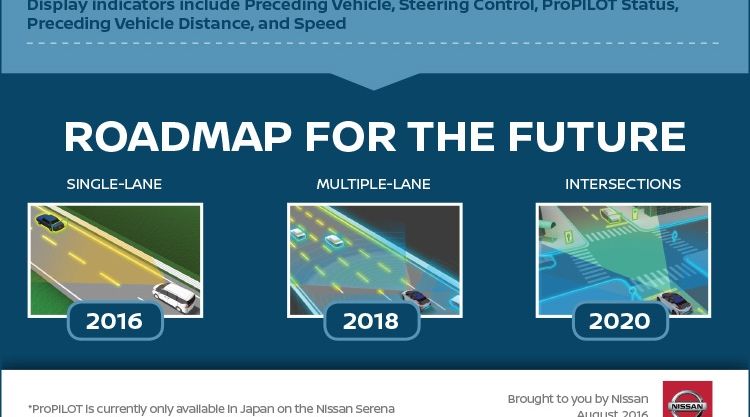Nissan has revealed new details about the development of its ProPilot semi-autonomous technology, including setting a timetable of 2020 to launch a more developed version that can tackle different sets of road conditions without the aid of a human driver. For now, the technology is only able to drive on a single lane in each direction, including the ability to follow lane markers, control steering on curves, and adjust its pace accordingly in the event the preceding vehicle changes lanes or another vehicle cuts into the lane it’s on.
In addition to these abilities, the ProPilot system is also able to drive at speeds between 18 mph to around 81 mph while also being able to automatically calculate a safe distance behind the car it’s following. In traffic conditions, the system can stop by itself without the driver applying any pressure on the brake pedal and resume driving by itself as well. It can also steer within its lane and has a display that shows the system’s performance.
By 2018, Nissan is confident that the ProPilot will be able to tackle numerous lanes and handle more complex driving situations. The company isn’t specifying how it plans to get to that point, but Nissan researcher Melissa Cefkin admitted that it’s a process that’s going to take some time to develop. The automaker also said that it’s not going to be pressured into rushing the development of the system, even if rival automakers begin applying their own versions of the technology into their cars.
That said, Nissan is also not waiting for the tech to be as versatile as it hopes before it starts offering it on any of its vehicles. Even with its current capabilities, the ProPilot system is already available on the Serena van in Japan. The company is expected to begin offering the system in other models, most notably, the European-spec Qashqai SUV by 2017 and a slew of other models in the U.S. and China.
Continue after the jump to read the full story.
Why it matters
You have to appreciate Nissan’s measured approach in the development of its ProPilot semi-autonomous technology and the honesty by which it describes the pace of development it has for the system. Nobody would blame Nissan if it rushed the development of the tech given the current competitive environment of the industry, but the Japanese automaker is opting for the more prudent option of developing the tech on its own terms.
This kind of approach doesn’t bound Nissan to rush its own program for the car as it gives the company time to develop the tech at its own pace. It’s a different tactic than what Tesla is doing, which already offers its own Autopilot system on its cars while making on-the-fly updates depending on how customers are responding to the tech. That method has its own advantages, but as we’ve seen from the spate of accidents being blamed on Autopilot, it also has its disadvantages.
What Nissan is doing is it’s developing ProPilot on its own terms and it’s using what it describes as “key lessons” on what autonomous vehicles are capable of when they’re developed right. That’s an approach that I’m on board with because it shows that Nissan, more than anything else, wants to have a product that consumers can fully trust.


